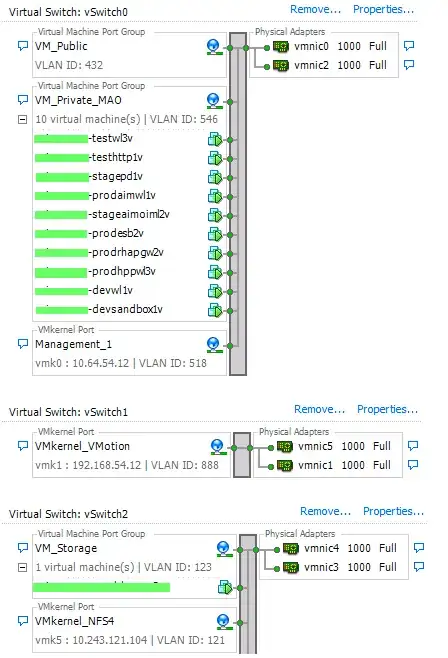I have a BNT (now an IBM) RackSwitch G8264 and am having problems trying to get standard VLANs configured and working with my two ESXi 5.5 hosts.
I've followed the documentation (which can be found here) for the version of switch software I am running, and I believe I have configured the VLANs correctly. However, when I create a standard port group on both my ESXi hosts and tag them with my newly created VLANs, traffic does not work. If I do not tag any traffic on the standard ESXi port group, everything works fine.
Here is my current setup:
2 x ESXi hosts running 5.5 update 1.
Standard switch with one physical adapter uplink.
One port group tagging on VLAN 202 with test VMs connected to them.
Switchports set to trunk mode with a default VLAN (for untagged packets) of 1 and allowed VLANs of 1 and 202.
If I set the VLAN ID in both port groups on each host to 202, the VMs on each host can not ping each other.
If I set the VLAN ID in both port groups on each host to 0 (None), the VMs on each host can ping each other successfully.
If I set the VLAN ID in both port groups on each host to 1, the VMs on each host can not ping each other.
So it seems that if I set any kind of VLAN tag on my port group on my ESXi hosts, communication fails.
What can I use on the switch or my ESXi hosts to inspect the frames to see if the tagging is happening? As far as I'm aware, you can't install Wireshark on a switch?
Any assistance would be appreciated.
Here is the entire dump of my switch config:
version "7.8.1"
switch-type "IBM Networking Operating System RackSwitch G8264"
iscli-new
!
ssh enable
!
interface port 53
description "ESXi 1"
switchport mode trunk
switchport trunk allowed vlan 1,202
exit
!
interface port 55
description "ESXi 2"
switchport mode trunk
switchport trunk allowed vlan 1,202
exit
!
vlan 202
name "VLAN 202"
!
!spanning-tree mode disable
!no spanning-tree stg-auto
!
!interface ip 1
addr <default>
enable
!
!interface ip 128
addr <default>
enable
!end'
